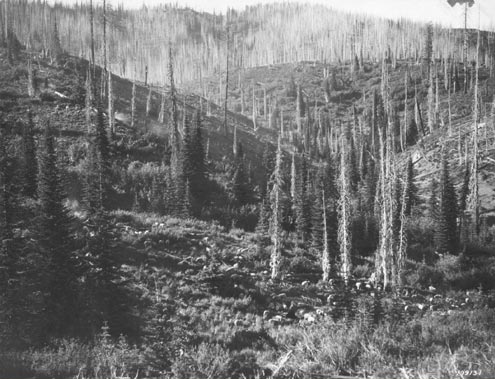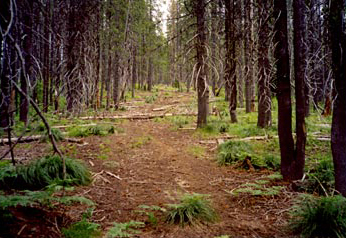In the Clearwater National Forest, one can still come across sheep driveways, wide lanes cleared of trees to move sheep to grazing areas.
Grazing the Clearwater National Forest
Sheep grazing near Hemlock Butte, Clearwater National Forest.[1]Kenneth D. Swan (1887-1970) was a photographer with the U.S. Forest Service, Northern Region. His photographs documented an important era in the history of the West.
Sheep-grazing in the American West usually brings to mind sageland deserts, but once in the not-too-distant past the high slopes of the Clearwater National Forest near K’useyneisket—The Nez Perce Road to the Buffalo—were prime summer ranges for domestic sheep. During the 1920s and ’30s, sheep grazing reached “boom” proportions here when thousands of acres of palatable plants covered the hillsides after the vast forest fires of the early 20th century.[2]Large fires burned on the Clearwater Forest in 1910, 1919, 1929, and 1932. Today, only a few old-timers can tell us much about the era when sheep grazed in the Clearwater National Forest.
Following each major fire, burned slopes became covered with fast-growing, sun-loving plants like fireweed, wild hollyhock, and redstem ceanothus—a burst of forage on the public domain that was sought by local sheepmen for fattening their lambs. Each summer, they trailed ewes and lambs across the forest toward Montana railheads and markets.
Forest Service records show a peak of 34,000 sheep using the summer ranges in 1934. After that, sheep grazing on the forest declined, as conditions changed. Trees grew back and shaded out the “transitory range.” The Forest Service followed the Taylor Grazing Act of 1934, imposing new regulations for grazing the public lands. And, after World War II, wool gave way to synthetics, lamb to beef.
Sheep Driveways
Each spring, after lambing and shearing was over, sheepmen trailed their flocks from low-elevation winter range near the Salmon River to the foothills of the Bitterroot Mountains near Weippe Prairie. From there, as winter snows slowly melted, they climbed toward the burned areas and open ridges at higher elevations, grazing during the cool mornings and evenings, and bedding down during the heat of the day and at night.
The sheep grazed in bands of about 1,000 ewes and their 1,500 lambs. Bands headed for Montana markets took all summer to graze across the forest toward railheads at Superior, Montana; other bands were shipped from Kamiah. Herders kept the bands moving and killed bears and other predators. They traveled on foot or horseback and camped in tents.[3]Road-building into the remote backcountry of the Clearwater National Forest started in the early 1930s. Corrals were built for sorting the flocks and sheep-sized bridges were strung across difficult crossings like Weitas Creek.[4]Weitas Creek is one of the largest tributaries of the North Fork of the Clearwater River. The Corps of Discovery looked down on its huge drainage area to the north of their ridge route for 20 miles … Continue reading
In 1924 a sheep “driveway” was surveyed and cut through the forest from Musselshell (near Pierce, Idaho) to Superior, a distance of roughly 80 miles. The road-sized swath with its network of side trails was used for 20 years as a travel corridor for bands to reach their allotments. One spur accessed the site Lewis and Clark called “Greensward Camp.” Today a rusted bedspring, a relic of an abandoned sheepherder’s camp, lies entangled in thick beargrass near there.
In places, it is still possible to see the old driveway because sections of it still appear as a cleared right-of-way. The trampling of thousands of hooves has compacted the soil and few trees have grown back, and on steeper sections, an eroded depression nearly two feet deep remains.
Environmental Effects
Some of the more common plants that stand out today on open ridge-tops and slopes in the high country are species sheep ignored 75 years ago. On drier sites, grass-like but wiry Drummond’s rush grows in thick, low clumps. In wet meadows, tall forbs like Western coneflower and false hellebore are common. A plant named “fleeceflower” (its sprays of tiny pale flowers resemble tufts of wool fleece) appears on most high ridges where sheep once grazed, summer after summer.
The gullied driveway, though insignificant in scale compared to the 1.8 million-acre Clearwater Forest, is a good example of how a direct effect like trampling the soil surface can contribute to long-term change in other parts of the environment. As soils become compacted, rainfall and snowmelt run overland instead of filtering into and through soil layers to recharge the ground water. Downslope streams receive this runoff all at one time instead of throughout the growing season. Increases in surface run-off also bring more sediment into the streams.
In the West, environmental effects of sheep grazing have been widely studied. Changes in water quality, vegetation composition, and altered fire regimes are traced to intensive grazing in some forested landscapes. On the Clearwater Forest, it is difficult to isolate sheep grazing as a cause for altered stream flows and lowered water quality when other practices like clearcut logging and road building also took place in the recent past. But the Forest’s goals for ecosystem restoration—to protect water quality for salmon recovery, contain the spread of noxious weeds, and restore the natural role of fire—have arisen because of all of these earlier practices and activities.
Today, outward signs of the sheep era have all but disappeared. The one-lane swinging bridge across Weitas Creek, the falling corral posts, and even the paths pressed into the mountains by thousands of sheep hooves, are fast disappearing under the lodgepole pines, alders, and snowbrush.
Bitterroot Mountain Plants
Fireweed, Epilobium angustifolium (ep-ih-LOBE-ee-um, “the corolla is borne on the end of the ovary”; an-GUST-ih-fole-ee-um, “narrow leaf”)
Wild hollyhock, Illiamna rivularis (ill-ee-AHM-na riv-yew-LARE-is, “of rivers”)
Redstem ceanothus, Ceanothus sanguineum (see-uh-NOTHE-us, from Greek “corn-thistle”; san-GWIN-ee-us, “blood red”)
Beargrass, Xerophyllum tenax (zero-PHIL-um, “dry leaf”; TEN-ax, “tenacious”)
Drummond’s rush, Juncus (JUNK-us; Latin name for rush) drummondii (drum-UN-dee-eye; for Thomas Drummond, early American plant collector)
Western coneflower, Rudbeckia occidentalis (rude-BEK-ee-a, for Olaf Rudbeck, Swedish botanist; ox-ih-den-TA-liss, “western”)
False hellebore, Veratrum viride (vehr-AY-trum, Latin for “hellebore,” perhaps from Greek hellos, “fawn,” and boros, “eaten”; VIR-a-dee, “green”). It was once believed that unicorns browsed on hellebore. Also known as corn lily.
Fleeceflower, Polygonum phytolaccaefolium (po-LIH-gonum, “many knees,” referring to the jointed stems; FIE-toe-lack-ih-FOLE-ee-um). It is sometimes considered an indicator of over-grazing.
Lodgepole pine, Pinus contorta Douglas ex Loud. var. latifolia Engelm. (PIE-nus, “pine”; con-TOR-ta, “pine with twisted needles”; variety lat-i-FOH-lee-uh, “straight needles”)
Alder, Alnus sitchenis (ALL-nuss, “alder”; sih-CHEN-sis, “of Sitka [Alaska]”)
Snowbrush, Ceanothus velutinus (see-a-NOTHE-us, from Greek “corn-thistle”; vell-yew-TINE-us, “velvety”)
Sources
Duane Annis, Forester (retired), Clearwater National Forest, Orofino, Idaho. Personal interview. March 8, 2004.
Joy A. Belsky and Dana Blumenthal. “Effects of Livestock Grazing on Stand Dynamics and Soils in Upland Forests of the Interior West. Conservation Biology 11:2 (April 1997), pp. 315-327.
Jim Mital, Ecologist, Clearwater National Forest, Orofino, Idaho. Personal interview. May 10, 2004.
Ralph Space, The Clearwater Story: A History of the Clearwater National Forest. Orofino, Idaho: USDA Forest Service R1-79-03, 1979.
Norm Steadman, Engineer, Clearwater National Forest, Orofino, Idaho. Personal interview. May 1, 2004.
Ruby Miles Stroschein, “Forgotten Sheep Trails: A Legacy of Sheep Grazing on the Clearwater Forest.” Unpublished manuscript. Moscow, Idaho: 1999.
Notes
| ↑1 | Kenneth D. Swan (1887-1970) was a photographer with the U.S. Forest Service, Northern Region. His photographs documented an important era in the history of the West. |
|---|---|
| ↑2 | Large fires burned on the Clearwater Forest in 1910, 1919, 1929, and 1932. |
| ↑3 | Road-building into the remote backcountry of the Clearwater National Forest started in the early 1930s. |
| ↑4 | Weitas Creek is one of the largest tributaries of the North Fork of the Clearwater River. The Corps of Discovery looked down on its huge drainage area to the north of their ridge route for 20 miles between ‘Sinque’ Hole Camp and Bowl Butte. |


